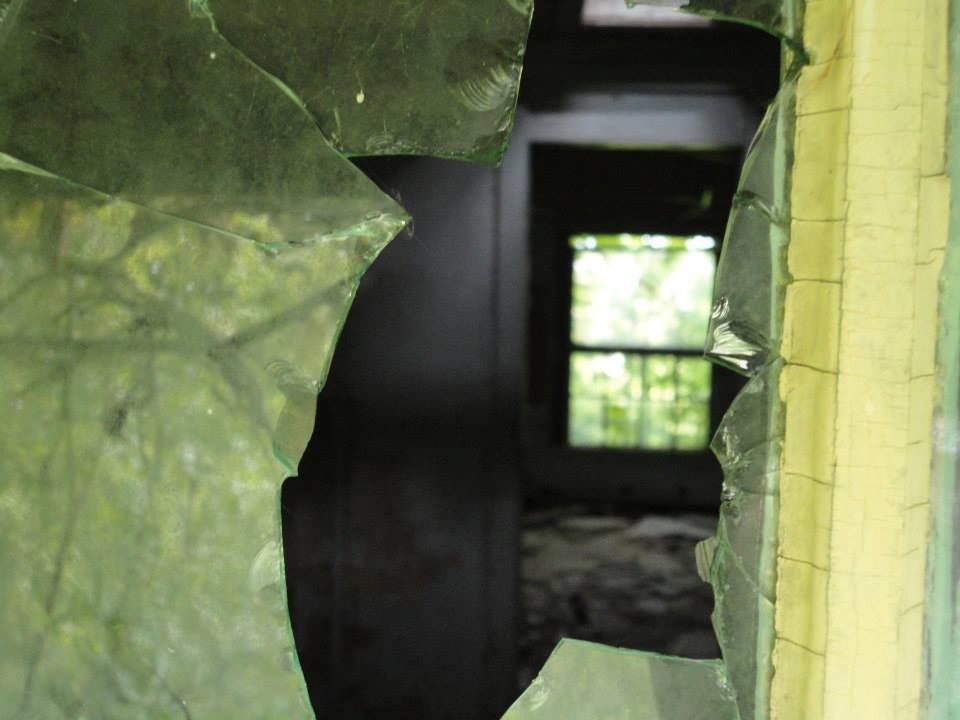This article was scraped from Rochester Subway. This is a blog about Rochester history and urbanism has not been published since 2017. The current owners are now publishing link spam which made me want to preserve this history.. The original article was published June 10, 2013 and can be found here.
![The abandoned Iola Tuberculosis Sanatorium. [PHOTO: Sarah Barnes]](https://senseofplace.dev/content/images/photos/iola-tuberculosis-sanatorium-001.jpg)
The following photographs were submitted by Sarah Barnes . The historical text is taken from a Historic Resource Evaluation prepared for Monroe County in 2000 by Bero Associates.
Submit your story today .
RocSubway fans, This past Sunday morning (6/2/13), I went with a friend of mine to check out the Iola Campus site

. I have lived in Rochester all my life and I have always been intrigued by those buildings (my aunt actually used to live in the apartments across the street). About 6 months ago, I started a little urban exploring group with some friends and coworkers; Iola was one of the first places of interest. With the CityGate project fast approaching, I knew I had to take the risk and visit Iola while I still could. Rather than taking a big group, just two of us went since we were not sure what the security situation would be like. The whole campus was great. A lot of the buildings had pretty easy access points, but there were a couple we could not get in to, due to time constraints (and proximity to the main road!). I hope that you all enjoy the shots! - Sarah Barnes
![The abandoned Iola Tuberculosis Sanatorium. [PHOTO: Sarah Barnes]](https://senseofplace.dev/content/images/photos/iola-tuberculosis-sanatorium-020.jpg)
The former campus of Monroe County Tuberculosis (Iola) Sanatorium is located at the southeast corner of Westfall and East Henrietta Roads in the southeast quadrant of the City of Rochester. The complex consists of nine buildings constructed between 1911 and 1931 as a residential and out-patient treatment center for persons suffering from tuberculosis.
The Iola complex is laid out as a park-like campus in a style typical of institutional planning in the first quarter of the twentieth century. The buildings are arranged informally and are set amidst sweeping lawns and mature specimen trees.
![The abandoned Iola Tuberculosis Sanatorium. [PHOTO: Sarah Barnes]](https://senseofplace.dev/content/images/photos/iola-tuberculosis-sanatorium-130.jpg)
The buildings represent the Neoclassical, Georgian Revival, Craftsman, Art Deco and Beaux Arts architectural styles. One of the major architects of Iola was Siegmund Firestone who also designed Monroe Community Hospital (built 1930-32).
![The abandoned Iola Tuberculosis Sanatorium. [PHOTO: Sarah Barnes]](https://senseofplace.dev/content/images/photos/iola-tuberculosis-sanatorium-128.jpg)
At the midpoint of the entrance walk is a circular shaped terrace with cast stone benches, contoured to follow the circular shape of the terrace. The terrace was originally lit by four fluted cast iron light poles with translucent acorn style globes. Two of the poles remain.
![The abandoned Iola Tuberculosis Sanatorium. [PHOTO: Sarah Barnes]](https://senseofplace.dev/content/images/photos/iola-tuberculosis-sanatorium-007.jpg)
A natural rise at the site provides views of the Erie Canal, the Rochester outwash plain and distant hills located to the southeast. Most of the patient staff buildings were designed with sleeping porches, sun porches and wards oriented toward this view.
![The abandoned Iola Tuberculosis Sanatorium. [PHOTO: Sarah Barnes]](https://senseofplace.dev/content/images/photos/iola-tuberculosis-sanatorium-040.jpg)
Beginning in the 1960s, Monroe County began constructing [other] facilities for various county agencies.
![The abandoned Iola Tuberculosis Sanatorium. [PHOTO: Sarah Barnes]](https://senseofplace.dev/content/images/photos/iola-tuberculosis-sanatorium-041.jpg)
The entrance road, lined with an allee of mature sycamore trees, curbing and sidewalks, provide a formal entrance to the complex. Originally the sanatorium administration building was located in a semicircular island at the intersection of the entrance drive and the complex's primary road. Today the entrance drive is sealed off at the street.
![The abandoned Iola Tuberculosis Sanatorium. [PHOTO: Sarah Barnes]](https://senseofplace.dev/content/images/photos/iola-tuberculosis-sanatorium-036.jpg)
Children's Building (building 5): This sprawling symmetrical Georgian Revival building is the largest remaining building at the Iola complex. The building was designed by Rochester architect Horace T. Hatton as a children's treatment facility. The three-story steel-frame structure was constructed in 1927. The building's exterior walls are constructed with concrete block with a red brick veneer.
![The abandoned Iola Tuberculosis Sanatorium. [PHOTO: Sarah Barnes]](https://senseofplace.dev/content/images/photos/iola-tuberculosis-sanatorium-037.jpg)
The primary facade of this building is dominated by a projecting two-story, thirteen-bay main block with a shallow recessed seven-bay, two-story portico. The portico is supported by brick piers. The piers have cast stone pilasters applied to the front faces and cast stone foliated capitals... Two rooftop penthouses, with Bull's Eye windows at the front wall, align with the end bays of the portico below. The penthouses' pyramidal standing seam metal roofs are modern additions.
![The abandoned Iola Tuberculosis Sanatorium. [PHOTO: Sarah Barnes]](https://senseofplace.dev/content/images/photos/iola-tuberculosis-sanatorium-034.jpg)
The building contains two principal public spaces; the entrance lobby and an auditorium. The lobby originally was a light and airy space, occupying the full width of the main block and providing visitors access to the view south. The south portion of the lobby has been partitioned in to a separate room. The lobby's remaining significant features include 18 inch black and white floor tile, brown marble wainscot, freestanding piers with Tuscan capitals, beamed ceiling, projecting wood vestibule enclosure with herringbone tile floor, gumwood trim and public counter, and original hanging light globes with floral/swag design.
![The abandoned Iola Tuberculosis Sanatorium. [PHOTO: Sarah Barnes]](https://senseofplace.dev/content/images/photos/iola-tuberculosis-sanatorium-042.jpg)
The east wing contains classrooms and an auditorium. The west wing originally housed dining, a kitchen and service functions. A one-story brick-cladd addition, housing the county's traffic control center, was added to the rear (south) corner of the west wing about 1980.
Much of the building's original interior detail was altered when the building was converted to county office space.
![The abandoned Iola Tuberculosis Sanatorium. [PHOTO: Sarah Barnes]](https://senseofplace.dev/content/images/photos/iola-tuberculosis-sanatorium-043.jpg)
Two symmetrical two-story dormitory wings project from the rear (southeast side) of the central pavilion. The exterior wall surfaces of the dormitory wings are dominated by numerous large multi-light double-hung windows and doors providing light, ventilation, and ready access to the outdoors.
![The abandoned Iola Tuberculosis Sanatorium. [PHOTO: Sarah Barnes]](https://senseofplace.dev/content/images/photos/iola-tuberculosis-sanatorium-046.jpg)
Around the perimeter of each wing are continuous broad concrete terraces. At the three-sided courtyard located between the two dormitory wings, the area between the terraces, originally occupied by an ornamental pool, is now planted with a grove of spruce trees.
![The abandoned Iola Tuberculosis Sanatorium. [PHOTO: Sarah Barnes]](https://senseofplace.dev/content/images/photos/iola-tuberculosis-sanatorium-047.jpg)
In most cases the original plaster ceilings are now concealed by acoustical suspended ceilings and the original oak doors and casings have been replaced with steel frames and doors.
![The abandoned Iola Tuberculosis Sanatorium. [PHOTO: Sarah Barnes]](https://senseofplace.dev/content/images/photos/iola-tuberculosis-sanatorium-057.jpg)
Nonetheless a few significant period finishes and features remain. At a classroom in the north end of the east wing are oak cabinets with glass multi-light doors, vertically sliding slate chalkboards, and a terrazzo floor and base.
![The abandoned Iola Tuberculosis Sanatorium. [PHOTO: Sarah Barnes]](https://senseofplace.dev/content/images/photos/iola-tuberculosis-sanatorium-064.jpg)
Connecting a corridor to the room adjacent to the above described classroom is an oak door surround including two light hopper transoms, six-light sidelights, and six-light double doors.
![The abandoned Iola Tuberculosis Sanatorium. [PHOTO: Sarah Barnes]](https://senseofplace.dev/content/images/photos/iola-tuberculosis-sanatorium-066.jpg)
At the southeast corner of the same wing an office retains a row of recessed quarter-sawn oak bookcases with six-light glass doors and turn-latch hardware.
![The abandoned Iola Tuberculosis Sanatorium. [PHOTO: Sarah Barnes]](https://senseofplace.dev/content/images/photos/iola-tuberculosis-sanatorium-069.jpg)
HISTORIC OVERVIEW: In 1882, Dr. Robert Koch, a German researcher, isolated the tubercle bacillus, the causative agent of tuberculosis. With the cause identified, the mode of transmission of the disease became clear and hygienic steps to thwart transmission could be implemented. Several years later Doctor Edward Livingston Trudeau popularized the "fresh air cure" for treatment of the disease at Saranac Lake in the Adirondack Mountains. The fresh air cure required exposure to outdoor air, a proper diet, and plenty of rest. Trudeau's method was widely adopted and by the early twentieth century, sanatoria for the treatment of tuberculosis had been establish across the nation.
![The abandoned Iola Tuberculosis Sanatorium. [PHOTO: Sarah Barnes]](https://senseofplace.dev/content/images/photos/iola-tuberculosis-sanatorium-070.jpg)
In Monroe County the growing number of tuberculosis cases at the local hospitals during the first decade of the twentieth century led to the effort by the County Board of Supervisors to establish a sanatorium for tuberculosis treatment. The Board of Supervisors engaged in a protracted debate to determine whether the facility should be operated by the County or the City of Rochester.
![The abandoned Iola Tuberculosis Sanatorium. [PHOTO: Sarah Barnes]](https://senseofplace.dev/content/images/photos/iola-tuberculosis-sanatorium-072.jpg)
After that issue was resolved, the County's Public Buildings Commission undertook a survey of sixty-two potential sites. Despite opposition from some of the Town of Brighton community, use of the Westfall Road site was intiated in 1909 when a tent was erected to temporarily house a handful of patients. Through the winter of that year the tent was heated by kerosene burners. The following spring a portable house was erected on the site.
![The abandoned Iola Tuberculosis Sanatorium. [PHOTO: Sarah Barnes]](https://senseofplace.dev/content/images/photos/iola-tuberculosis-sanatorium-073.jpg)
Architect Charles F. Crandall was hired to design the sanatorium's first permanent buildings. Other works by Crandall included the Duffy Powers Building, Hotel Rochester, Cornwall Building, Franklin Street YMCA, many Kodak buildings, the American Laundry machinery buildings, schools and firehouses, and Grace Methodist Church.
![The abandoned Iola Tuberculosis Sanatorium. [PHOTO: Sarah Barnes]](https://senseofplace.dev/content/images/photos/iola-tuberculosis-sanatorium-075.jpg)
In 1914 school classes were begun on the campus. Classes were originally held in two tents furnished by Mr. and Mrs. Williams Bausch. Four years later, the campus underwent a major expansion. The three-story Infirmary was built near the center of the site and increased the sanatorium's capacity to 200 patients. At the same time, a service wing was added to the north side of the administration building to provide kitchen and dining facilities. A short time later, a large one-story surgical wing was added to the north side of the infirmary.
![The abandoned Iola Tuberculosis Sanatorium. [PHOTO: Sarah Barnes]](https://senseofplace.dev/content/images/photos/iola-tuberculosis-sanatorium-077.jpg)
The growing number of tuberculosis cases required continued expansion of the sanatorium. By the mid 1920s the facility was treating nearly 600 patients a year.
![The abandoned Iola Tuberculosis Sanatorium. [PHOTO: Sarah Barnes]](https://senseofplace.dev/content/images/photos/iola-tuberculosis-sanatorium-083.jpg)
As the facility grew the original leach field was replaced by a small waste water treatment plant, located on county land south of the complex, just north of the Erie Canal. The now demolished sewage plant was expanded over the years to serve the expanding sanatorium and the new Monroe County Community Hospital constructed across the street.
![The abandoned Iola Tuberculosis Sanatorium. [PHOTO: Sarah Barnes]](https://senseofplace.dev/content/images/photos/iola-tuberculosis-sanatorium-085.jpg)
A steam power plant was built in conjunction with the hospital. The power plant is linked to the buildings of the Iola complex as well as the Monroe County Community Hospital complex by an extensive system of concrete utility tunnels. Small flat-roof ventilators, serving the tunnels, are scattered around the complex grounds.
![The abandoned Iola Tuberculosis Sanatorium. [PHOTO: Sarah Barnes]](https://senseofplace.dev/content/images/photos/iola-tuberculosis-sanatorium-086.jpg)
In 1928 a four-story medical wing including x-ray facilities was added to the infirmary. In the late 1920s, with over 400 patients, the Iola Sanatorium was the largest county tuberculosis facility in New York State.
![The abandoned Iola Tuberculosis Sanatorium. [PHOTO: Sarah Barnes]](https://senseofplace.dev/content/images/photos/iola-tuberculosis-sanatorium-089.jpg)
A debate over the future use of the facility began in the Monroe County Board of Supervisors before the tuberculosis facility closed its doors [in 1964].
![The abandoned Iola Tuberculosis Sanatorium. [PHOTO: Sarah Barnes]](https://senseofplace.dev/content/images/photos/iola-tuberculosis-sanatorium-096.jpg)
Beginning in the mid 1960s, most of the existing buildings on the site were converted to office space and storage areas for county departments.
![The abandoned Iola Tuberculosis Sanatorium. [PHOTO: Sarah Barnes]](https://senseofplace.dev/content/images/photos/iola-tuberculosis-sanatorium-103.jpg)
The less easily adaptable administration and infirmary buildings were left vacant. Early in the 1970s the County began to develop the southern undeveloped portion of the property.
![The abandoned Iola Tuberculosis Sanatorium. [PHOTO: Sarah Barnes]](https://senseofplace.dev/content/images/photos/iola-tuberculosis-sanatorium-106.jpg)
The first building constructed was the Children's Detention Center located at the base of the slope just east of the former Children's Building.
![The abandoned Iola Tuberculosis Sanatorium. [PHOTO: Sarah Barnes]](https://senseofplace.dev/content/images/photos/iola-tuberculosis-sanatorium-108.jpg)
During the 1980s several large public works buildings, including the Pure Waters Operations and Storage Facility and the County Fleet Maintenance Garage were built on the site of the former waste water treatment facility.
![The abandoned Iola Tuberculosis Sanatorium. [PHOTO: Sarah Barnes]](https://senseofplace.dev/content/images/photos/iola-tuberculosis-sanatorium-109.jpg)
In 1975 the Administration Building was demolished and the area it occupied was converted to parking serving the county offices located in the former Children's Building. The Infirmary was demolished in 1982.
![The abandoned Iola Tuberculosis Sanatorium. [PHOTO: Sarah Barnes]](https://senseofplace.dev/content/images/photos/iola-tuberculosis-sanatorium-117.jpg)
In 1999 Monroe County, citing high maintenance costs and the desire to consolidate county offices, relocated the county departments housed at the site to leased space in downtown Rochester.
![The abandoned Iola Tuberculosis Sanatorium. [PHOTO: Sarah Barnes]](https://senseofplace.dev/content/images/photos/iola-tuberculosis-sanatorium-125.jpg)
The Iola campus is slated to be replaced with CityGate . * * *
About Sarah Barnes:
Sarah is a Rochester native who is currently working at Bausch and Lomb. She is fascinated by Rochester's history and is always looking for urban exploration opportunities. She lives with her husband and son in East Rochester. These are only a few of the images from Sarah's complete photo album. The full set can be view on Facebook .


